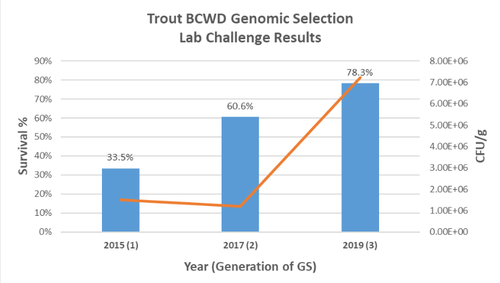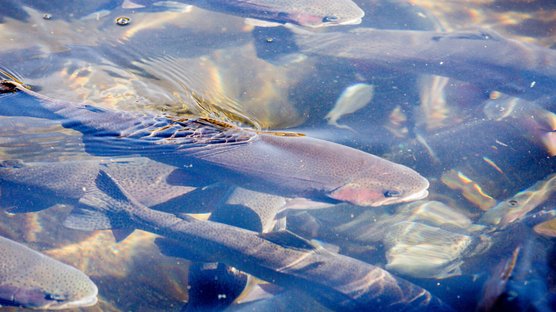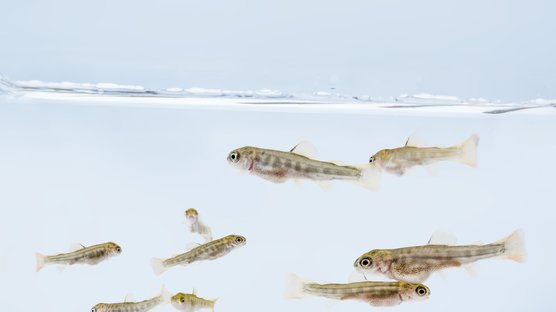
Published on May 19, 2020
Enhanced resistance to BCWD in Troutlodge strains
Joint research of the United States Department of Agriculture (USDA) and Troutlodge has shown that Genomic Selection can double the prediction accuracy for Bacterial Cold Water Disease (BCWD). Application of Genomic Selection for BCWD resistance to three generations of Troutlodge broodstock resulted in a challenge survival increasing from 33.5% in 2015 to 78.3% in 2019. This is a staggering improvement of 134%.
Seven years ago, Troutlodge, the world leading supplier of rainbow trout eggs, and the USDA formed a long term collaboration to help combat this worldwide problem. The approach included use of genomic selection, the concept of using genome-wide dense genetic maps to predict the genetic merit of individual animals, and enhance selective breeding efficiency. Troutlodge and the USDA worked together to increase selection accuracy for BCWD, and apply the technology to commercially available broodstock. Already in 2017, we saw an improvement of 80% in survival. Since that time, Troutlodge eggs with enhanced survival to BCWD are sold successfully. The eggs commercially available today with enhance resistance to BCWD demonstrate even much better resistance.
Infectious diseases remain the single largest cause of production related mortality in the rainbow trout industry, accounting for 81% of the total losses in 2011 (NASS, 2012). Flavobacterium psychrophilum, the bacteria that causes BCWD, causes substantial losses in industry (Duchaud et al. 2007, Nematollahi et al. 2003).
Flavobacterium psychrophilum is endemic worldwide and impacts both traditional and aquaculture related salmonid production. The pathogen causes outbreaks of both BCWD and rainbow trout fry syndrome, of which outbreaks can cause mortality of up to 85% (Brown et al. 1997). A significant amount of research has been done in attempts to develop protection from F. psychrophilum, however no effective vaccine has yet been produced, and the molecular pathogenesis involved with infections are not well understood (Barnes 2011, Cipriano et al. 2005, Duchaud et al. 2007).
Antibiotic approaches for treatment and prevention of outbreaks have been widely used, however medication adds to production costs in both materials and labor, and the efficacy is variable as antibiotic resistant bacteria are continually evolving (Barnes 2011, Bruun et al. 2000, Bruun et al. 2002, Kum et al. 2008). For these reasons Flavobacterium psychrophilum continues to be a significant burden to trout aquaculture worldwide.
Timeline of Research Activities:
2010 –
- Troutlodge performs customer survey to determine traits with the most commercial impact worldwide. Disease resistance (including to BCWD) is amongst the top rated traits for improvement.
2013 –
- BCWD laboratory challenges are performed on Troutlodge stocks by USDA researchers.
2014 –
- USDA completes develops a 57K SNP chip necessary for genome wide association studies and genomic selection. Troutlodge genetic stocks are utilized for SNP selection and validation.
2015 –
- First application of genomic selection to commercial rainbow trout populations. GEBVs produced by USDA and selections carried out on Troutlodge commercial broodstock.
- BCWD laboratory challenges of offspring reveal that use of genomic selection doubled the selection accuracy compared to traditional selection methods. See publication in supplemental materials (Vallejo et al. 2017).
2016 –
- BCWD laboratory challenges conducted by USDA on another Troutlodge commercial strain.
2017 –
- Troutlodge offers commercially available eggs that have been selected for BCWD resistance using genomic selection. This represents the first commercially available trout eggs selected via genomic selection.
- Application of genomic selection on second generation of Troutlodge commercial stocks.
2018 –
- Troutlodge expands use of genomics selection to additional strains for extended commercial availability.
- Modification of breeding programs begins for improved efficiency of BCWD resistance selection.
2019 –
- Genomic selection on 3rd generation for enhanced BCWD resistance.
- Laboratory challenges to evaluate selection response.
- Expansion of genomic selection methodology to additional pathogens with significant impact on rainbow trout culture.
2020 –
- First generation of genomic selection for BCWD in November strain.
- BCWD laboratory challenges on February strain nucleus – setting stage for genomic selection.
Methods
Disease challenge methods can be found in Vallejo et al. 2017. To summarize, representatives from Troutlodge’s nucleus populations shipped as eggs to the USDA. At approximately 1g in size, fry were IP injected with F. psychrophilum at the prescribed amount (Figure 1). Mortality was recorded daily for 21 days.

Figure 1: Results of BCWD laboratory challenges conducted by the USDA on Troutlodge’s May strain. The graphic shows generational improvements in survival from 2015 to 2019 as a result of genomic selection.
Generational improvements are consistent, despite increased severity of bacterial load (CFU/g) from 2015 to 2019.
Application of genomic selection for BCWD resistance across 3 generations resulted in a challenge survival increasing from 33.5% in 2015 to 78.3% in 2019, an improvement of 134%.
References
Barnes M.E., M. L. Brown. 2011. A Review of Flavobacterium Psychrophilum Biology, Clinical Signs, and Bacterial Cold Water Disease Prevention and Treatment. The Open Fish Science Journal; 4:40-48.
Brown, L.L., W.T. C o x, R.P. Levinel. 1997. Evidence that the causal agent of bacterial coldwater disease Flavobacterium psychrophilum is transmitted within salmonid eggs. Diseases of Aquatic Organisms; 29: 213-218.
Bruun M.S., A. S. Schmidt, L. Madsen, I. Dalsgaard. 2000. Antimicrobial resistance patterns in Danish isolates of Flavobacterium psychrophilum. Aquaculture 187: 201-212.
Cipriano, R.C. and R.A. Holt. 2005. Flavobacterium psychrophilum, cause of Bacterial Cold-Water Disease and Rainbow Trout Fry Syndrome. Fish Disease Leaflet No. 86. United States Dept. of the Interior. U.S. Geological Service, National Fish Health Research Laboratory, Kearneysville, WV.
Duchaud, E., M. Boussaha, V. Loux, J. Bernardet, C. Michel, B. Kerouault, S. Mondot, P. Nicolas, R. Bossy, C. Caron, P. Bessieres, J. Gibrat, S. Claverol, F. Dumetz, M. Le Henaff, A. Benmansour. 2007. Complete genome sequence of the fish pathogen Flavobacterium psychrophilum. Nature Biotechnology; 25: 763-769
FAO 2016. Fisheries and Aquaculture Department, Global Aquaculture Production 1950-2016. By species. Accessed Feb 7, 2018, http://www.fao.org/figis/servlet/TabSelector.
Kum, C., S. Kirkan, S. Sekkin, F. Akar, M. Boyacioglu. 2008. Comparison of In Vitro Antimicrobial Susceptibility in Flavobacterium psychrophilum Isolated from Rainbow Trout Fry. Journal of Aquatic Animal Health; 20: 245-251.
NASS. 2018. Trout Production. National Agricultural Statistics Service. USDA, Washington DC. Accessed February 20, 2019. https://downloads.usda.library.cornell.edu/usda-esmis/files/t722h882h/cn69m647s/b8515q80p/TrouProd-02-26-2018.pdf
Nematollahi, A., A. Decostere, F. Pasmans, F. Haesebrouck. 2003. Flavobacterium psychrophilum infections in salmonid fish. Journal of Fish Diseases, 26:563-574.
Vallejo, R., T. D. Leeds, G. Gao, J.E. Parsons, K.E. Martin, J.P. Evenhuis, B.O Fragomeni, G.D, Wiens, Y. Palit. 2017. Genomic selection models double the accuracy of predicted breeding values for bacterial cold water disease resistance compared to a traditional pedigree-based model in rainbow trout aquaculture. Genetics Selection and Evolution. 49:17


